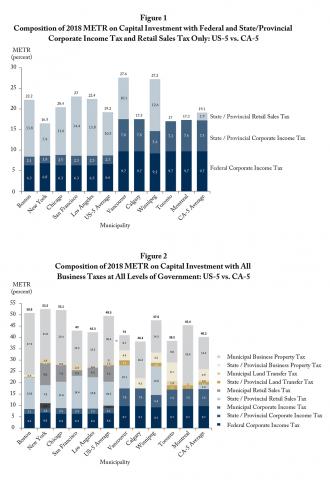From: Adam Found and Peter Tomlinson
To: Business Investors
Date: October 18, 2018
Re: Tax Barriers to Investment – Large Canadian Cities Edge Out US Competitors
Governments across Canada have made it a policy priority to reduce the marginal effective tax rate (METR) on each new dollar of business investment. By incorporating various business taxes, the METR is a standardized and widely accepted composite measure of the burden business taxation places on investment. The higher the METR, the greater the investment loss and overall economic harm arising from business taxation.
The United States’ Tax Cuts and Jobs Act has substantially enhanced that country’s business tax environment. The centrepiece of this reform was a marked reduction in the federal corporate income tax rate, from 35 to 21 percent, effective January 1, 2018. Naturally, such a shift in the business tax landscape would lead METR analysts and Canadian governments to wonder: Are Canada’s largest cities now outcompeted by their counterparts in the United States?
To help answer this question, we compared five American cities (Boston, New York, Chicago, San Francisco and Los Angeles) with five Canadian cities (Vancouver, Calgary, Winnipeg, Toronto and Montreal).
In a forthcoming C.D. Howe Institute E-Brief, we compare these five American cities (the US-5) with the five largest Canadian cities (the CA-5). When consideration is limited to mainstream business taxes — i.e., federal and provincial corporate income taxes and un-harmonized retail sales taxes — the US tax reform appears to leave that country and Canada equally competitive: the US-5 average METR for these taxes is 19.2 percent compared with 19.1 percent for the CA-5 (see Figure 1). However, once local taxes and provincial/state business property taxes are added, these METRs become 49.5 and 40.2 percent, respectively, revealing an appreciable advantage for Canada (see Figure 2).
Since 2006, when METRs on capital investment first appeared in Canadian budget documents, the federal government and many provinces have reduced business taxes. However, prevailing METR estimates, such as those prepared by the School of Public Policy at the University of Calgary, continue to exclude business property taxes. Our work, which examined a number of Canadian cities, found that business property taxes represent about half the total METR on corporate investment. METR estimates missing half the story can misrepresent business tax competitiveness and thus misinform policymaking.
When investors evaluate locations, they have to look at alternative cities as well as alternative countries, provinces and states. While average METR results for 10 cities won’t necessarily apply to all of urban North America, they could prompt investors who are only considering US locations to cast their eyes northward.
Adam Found is a Policy Fellow at the C.D. Howe Institute and Peter Tomlinson is a Sessional Lecturer at University of Toronto.
To send a comment or leave feedback, email us at blog@cdhowe.org.
The views expressed here are those of the authors. The C.D. Howe Institute does not take corporate positions on policy matters.






